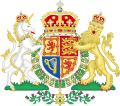History
The office of marischal of Scotland (or Marascallus Scotie or Marscallus Scotiae) had been hereditary, held by the senior member and chief of Clan Keith, since Hervey (Herveus) de Keith, who held the office of marischal under Malcolm IV and William I. The descendant of Herveus, Sir Robert de Keith (d.1332), was confirmed in the office of Great Marischal of Scotland by King Robert the Bruce around 1324.
Robert de Keith's great-grandson, William, was raised to the peerage as earl marischal by James II in about 1458. The peerage died out when George Keith, the 10th Earl, forfeited it by joining the Jacobite Rising of 1715.
The role of the Marischal was to serve as custodian of the regalia of Scotland, and to protect the king's person when attending parliament. The former duty was fulfilled by the 7th Earl during the Wars of the Three Kingdoms, who hid them at Dunnottar Castle. The role of regulation of heraldry carried out by the English earl marshal is carried out in Scotland by the Lord Lyon King of Arms.
The separate office of knight marischal was first created for the Scottish coronation of King Charles I in 1633. The office is not heritable, although it has been held by members of the Keith family.
The title was forfeited in 1715, due to the last earl's participation in the Jacobite Rising.
This page is based on this
Wikipedia article Text is available under the
CC BY-SA 4.0 license; additional terms may apply.
Images, videos and audio are available under their respective licenses.




